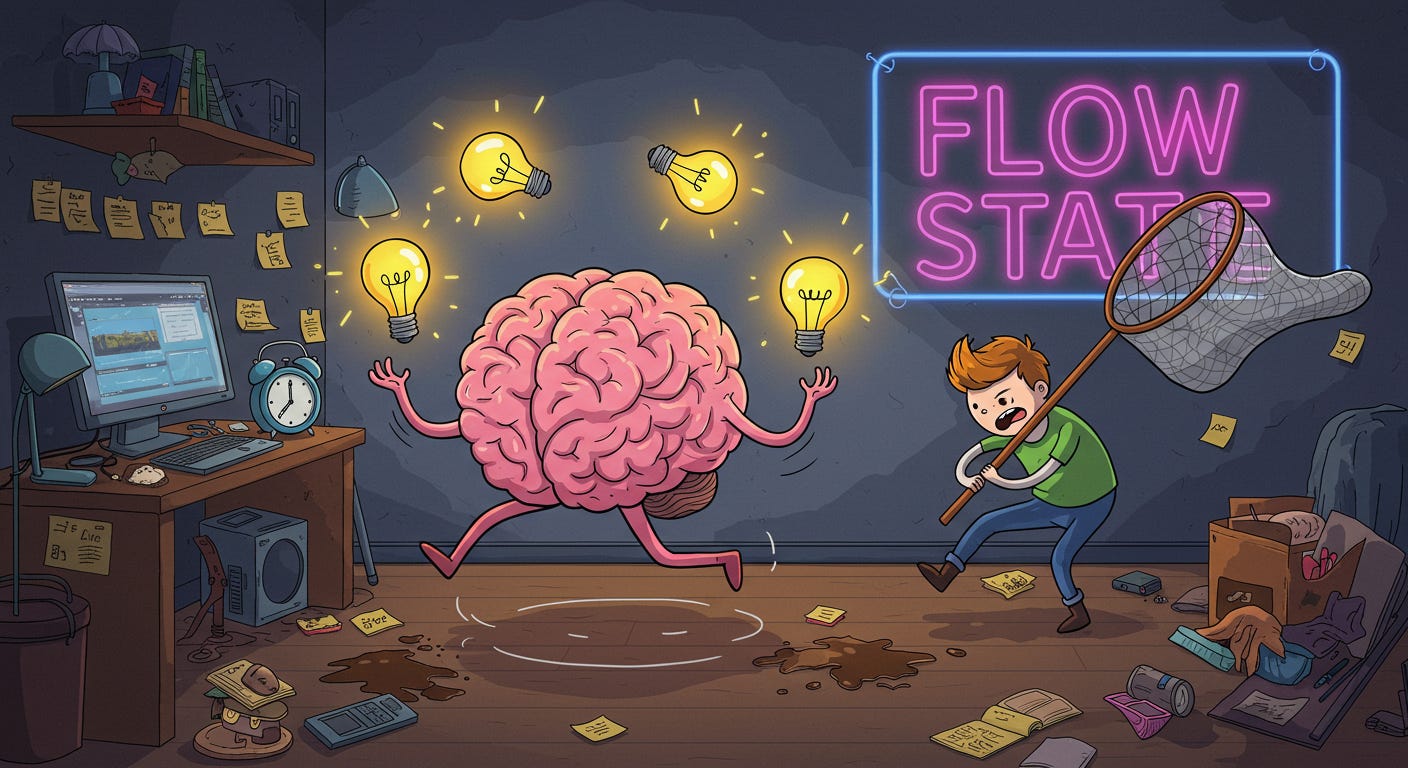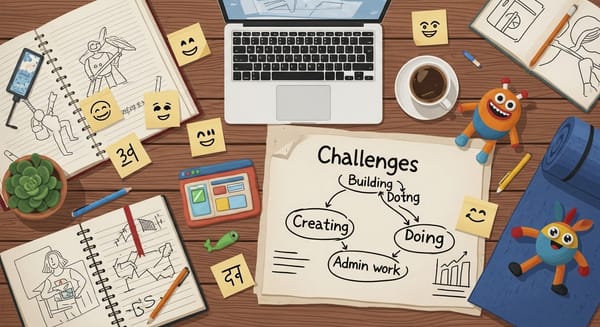It's your mind, baby!
This article is all about one's mind and what happens when it is a fast one. How to keep it in check? This is the start of the FastBrainer Series.

And how it is on us to figure out how it works to be more productive
All our brains work differently and for me, my brain was and still is a mystery.
It is raw, a dark big box and it consistently has its own mind - haha :D
But what is that, our mind and how do you go along when it follows its own rythm instead of your own?

The curse of the fast brain
Do you have a fast brain? One that thinks and thinks and thinks? One that loves to see 100 and 1 solutions to every problem and that loves to explore and investigate them all at once?
Then there is a high chance you have a fast brain. And what that fast brain does is it loves to use that power always and ever. It loves that excitement of that deep investment in a task, the flow state of focusing on one thing.
In technical, in psychological terms, there is a concept for that - flow state. Mihaly Csikszentmihalyi, the researcher, who researched and wrote about it, describes it as a deep state of involvement, of optimal experience, where we are so intensely engrossed in an activity that nothing else seems to matter. And that we enjoy that state of effortless action.
But what if that flow state can on one hand produce amazing results, but on the other hand, leads to shutting down and pushing away all things that are important in that moment? What if a flow state per se may be an amazing experience, but it also serves as a moment of fleeing? A moment of the fast brain going havoc? Going into its own brain?
When my fast brain goes into this state, I see two things happening:
- I am all-engrossed in the state, fully there, fully enjoying the experience. And I am either leaning something deeply, immersing myself deeply or producing great results fast (i.e. programming, consuming news, writing books, etc)
- I lose touch with the outer world. I brush away friends and family, I stop working on my admin tasks, I feel like my mind is drawn to the task at hand. When the activity spans more than a day, the next day I make plans and the moment I wake up, my brain throws them overboard and goes deep again. Like a magnet that is drawn to its other half
While one could argue - hey, let the brain do whatever it wants to do. There is a big issue with that. One that we just saw. Going into flow state takes away the very essence life needs to survive - doing work to grow, to connect with people, to move into a direction.
And yet, how do you work with a fast brain, when you cannot purely ignore its need for deep flow states, but at the same time the activity of flow keeps yourself from focusing on growing and building your life?
The work with the fast brain
The million dollar question :D
How to find that striking balance when its almost impossible to stop your brain from going into that beloved flow state?
And once its in there, it has no plan to get out of it again until it’s done? Which can take between several hours to weeks?
There is no right answer, there is no right toolbox, but thats why we are here - to give you a toolbox, an idea, some experiments you should do to work with your fast brain.
It’s what I am doing - running experiments to see: what is the best for the fast brain to work with.
Here are some of those experiments:
Time Boxing
When you box your time into one hour to several hour boxes, you make sure to stop yoru brain from going havoc and finding whatever topic it loves right now to dive deep. You basically set constraints.
You say, in this hour, we only do that task. One task and nothing else. Once we are done, you can relax in that hour, you can do something else. But when the time is up, it’s time for you to get out of that task.
For me, this method works rather well in the morning an for tasks that are not too flow-staty, but those that are flow-staty and the fast brain is overly in love with them, it can be hard.
What I advise you to try is to set alarms, loud and clear, with your phone far away from your own sitting area.
You give your brain a break. This short ‘out of the experience’ moment, where you break the pattern of deep dive and allow yourself to think with a clear mind and the understanding of “'it’s time to do something else’ sweeps in.
This often helps to break the fast brains excitement and need to stay in that flow state.
Don’t work after food
Another strategy is the don’t work after food strategy. I came up with it, as I realized how much worse my brains focus on work is after food. When I had lunch or dinner or else, I would shortly after be in a vulnerable place - my brain would be especially excited to go into the flow state. And it is even more difficult to get it out of the need for its flow state.
And with that comes my third advice:
Know your trigger points
Make a list with your trigger points. What are those triggers that lead to the flow state of your brain with higher probabilities? Is it the lunch and after-food times, is it - as also for me - the long sitting in one place, where the brain then drifts into its state or is it the tiredness of your body that excites your brain to go in overmode?
The better you know yourself and your trigger points, the more you can create countermeasures.
Think of it that way - your fast brain loves to go into flow modes, and it is very creative in finding ways where you scrumble, where you are not fully there, where you are tired and feel the heat of the day. These are the moment your fast brain snatches a chance and like a snake glides through the forest of the day and presses that button: “It is my time now, back off.”
For you to succeed, you need to learn what these are, so that you can develop countermeasures. And here are some of them - following our time boxing example.
Triggers Solved
You see the trigger: After food, I am falling into my trigger mode more often?
Then the answer could be: After food, there is no work. Instead, there is at least 30min of work. To relax the mind and focus the day.
You see the trigger: Once I am in an activity, I tend to overshoot and forget the time?
Then the answer could be: I set a timer for the whole day, every day, and every two hours, just in case for the whole day. So my brain has at most two hours where it can overshoot and goes into its flow state.
You see the trigger: When I don’t have a goal, my fast brain still finds a goal and dives right into its flow state.
Then the answer could be: Set a goal for the day and write it on a sheet of paper. Put it in your pocket, hang it on the wall, carry it with you wherever you go. So it manifests.
More creative technical answer? Have the answer pop up on your screen from time to time. ;) It gives your brain a short break, brings you back to the activity at hand and is a bit like an Easter egg hunt - fun and surprising ;)
Next steps
You have a fast brain that just loves flow states? Then find your triggers and experiment with your trigger solvers. The more you do, the better you find answers on how to work with your fast brain.
And if you need help doing so, send me an invite and we can talk about it.
Best,
Frederike




